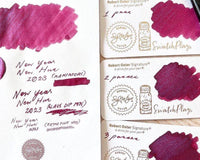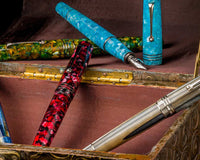While writing out your to-do list or daily journal entry, you may have paused and thought about what goes into your trusty fountain pen. As writing enthusiasts, we sometimes can’t help but marvel at how well-made our fountain pens are. But what exactly are they made of? To answer this question, we’ll be taking you through the basics of fountain parts and sharing some of the common and unique materials that are used to make fountain pen bodies and nibs.
What fountain pens are made of

Fountain pens are made of a wide variety of materials. It is here that pen manufacturers can get creative when designing and producing different pens.
The barrel
In the past, the first barrels were usually made of hard and black rubber. These were chosen for their ink resistance and because they were easy to create. Modern manufacturers often use high-quality plastics for many fountain pen barrels, such as acrylic resin. In fact, this material is used in models such as the famous Parker 51. Other materials such as cellulose acetate and other injection-moldable polymers are also used to create different designs.
You’ll also see more high-quality materials being used today, such as stainless steel, silver, brass, wood, and gold. Some pens are also coated in precious materials such as urushi lacquer.
The nib
The most common material used to create a fountain pen nib is stainless steel, but you’ll also find that more pen manufacturers are creating high-caliber pens with precious metals for the nib, such as gold. In fact, gold was more commonly used in the past because it provided a good balance between cost and durability. It eventually became too expensive to produce in larger quantities, which is why manufacturers turned to lower-cost alternatives such as stainless steel.
Apart from stainless steel, many nibs today are made of a combination of metals, especially for the tipping of the nib. Metals such as iridium are often used to further strengthen gold nibs and protect them from corrosion.
Other design elements
Other design elements are made from a variety of materials depending on the pen design and style. For instance, some pens use gold-plated steel clips and inlays. The detailing on a pen will depend on whether it is mass-produced or custom-designed. For custom pens, the manufacturer must carefully choose the appropriate tools and materials to create the special features of the pen. Variations in design elements will require extra materials and preparation, but they also help make the pen more unique and valuable.
Refill mechanisms
Many different mechanisms can be used to fill fountain pens. In the body of a fountain pen, you’ll often find filling mechanisms that involve squeeze bulbs, levers, buttons, and pistons. These are often made of plastic, rubber, and metal.
Fountain pens are made of many different types of materials, ranging from high-grade resins to stainless steel nibs and bodies. It helps to be discerning when choosing your fountain pen to ensure that you are buying one of quality. Knowing what to look for in a fountain pen is a must, and it can make all the difference in your writing experience.
Happy writing!
Written by EndlessPens Blogger Ramona Kabigting







